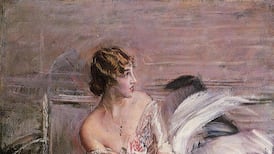I’m sure I speak for all Flann O’Brien fans in saying that a disappointment of Ireland’s belated confirmation as a global sporting powerhouse has been the continued failure of any jumping events to feature.
We have no representation, male or female, in the Olympic long jump, for example. The Hibernian high jumper is equally absent from Paris. As for the competition formally known as the hop, skip, and jump, Ireland appears to have done only the skip part, as usual.
So much for the international reputation boasted of in O’Brien’s 1939 novel At Swim-Two-Birds when, inspired by the legend of Mad King Sweeney hopping from tree to tree across Ireland, the characters go off on a self-congratulatory tangent:
“That was always one thing, said Shanahan wisely, that the Irish race was always noted for, one place where the world had to give us best. With all his faults and by God he has plenty, the Irishman can jump. By God he can jump. That’s one thing the Irish race is honoured for no matter where it goes or where you find it – jumping. The world looks up to us there.
READ MORE
We were good jumpers from the start, said Furriskey.”
Furriskey then embellishes the theme with a story “from the early days of the Gaelic League”, involving a Sergeant Craddock who, while keeping an eye on a nationalist sports day somewhere, is accused of being “a bloody English spy”.
There follows a trial of ethnic authenticity, in which Craddock is pitched into a jump-off against the Gaels’ champion, Bagenal.
The latter throws down the gauntlet via a leap of “twenty-two feet”: an achievement greeted, according to the narrator, with a roar that was “enough to make [Craddock] puke what was inside him and plenty more that he never swallowed”.
But puking or not, the policeman replies with a jump of “twenty-four feet six”, confounding the critics and proving his national credentials.
“I’m not surprised, said Shanahan in his amazement, I’m not surprised. Go where you like in the wide world, you will always find that the Irishman is looked up to for his jumping.
Right enough, said Furriskey, the name of Ireland is honoured for that.
Go to Russia, said Shanahan, go to China, go to France. Everywhere and all the time it is hats off and a gra-ma-cree to the Jumping Irishman. Ask who you like they’ll all tell you that. The Jumping Irishman.
It’s a thing, said Furriskey, that will always stand to us – jumping.”
Given a bit of media training, Furriskey and Shanahan would fit right in with some of RTE’s Olympic analysis panels. The pity, alas, is that their specialty event is again devoid of Irish involvement at this games, as at most.
Go to Russia, go to China, go to France these days and it’ll be hats off and gra-ma-cree to Ireland’s rowers, long-distance swimmers, women boxers, and even – God help us – practitioners of the pommel horse.
Before the week is out, the world may be acknowledging yet another Daniel Wiffen medal, this time in the 10km open water swim (provided the river Seine, to paraphrase Flann, doesn’t make him puke what’s inside him and plenty more he never swallowed).
But there is no grá, meanwhile, for our jumpers. Their glory – if it was ever real – has long faded.
The funny thing is that, behind the comic hyperbole in O’Brien’s book, there was a grain of truth. In the earlier years of the 20th century, Ireland did indeed produce some prodigious long jumpers.
These included the Limerick-born Dan Ahearne, who emigrated to the US and set a world Triple Jump record there in 1910, with a combined leap of 50ft. He thereby improved the previous best, set by another Limerick man, Dan Shanahan.
And yet Ahearne may not even have been the best triple jumper in his own family. His older brother Tim had won the gold medal at the Olympics in 1908, representing Great Britain.
Before that, there was Peter O’Connor, who also represented GB – reluctantly. His exploits included winning silver in the long jump and gold in the Triple at the 1906 games in Athens, then shinnying up a flagpole to replace the Union flag with a green one saying “Erin go Bragh”.
Five years earlier, in 1901, O’Connor had outleapt both the fictional Sergeant Craddock and the real-life world record holder Myer Prinstein to jump almost 25ft.
That was still unsurpassed anywhere until 1921, by which stage Ireland was about to achieve independence. But this last development seemed to have a detrimental effect on our jumping abilities, if not on Irish athletics in general.
It’s telling that at the first Olympics Ireland could compete in under its own flag, Paris 1924, our only medallists were artists: Jack B Yeats for painting and stately plump Buck Mulligan (aka Oliver St John Gogarty) for poetry.
The jumping Irishman, meanwhile, had embarked on a long and precipitous decline. Shockingly, O’Connor’s 25ft leap remained the national record for all of Flann O’Brien’s life and a quarter century beyond that. The mark was only finally beaten, 89 years after it was set, in 1990.









